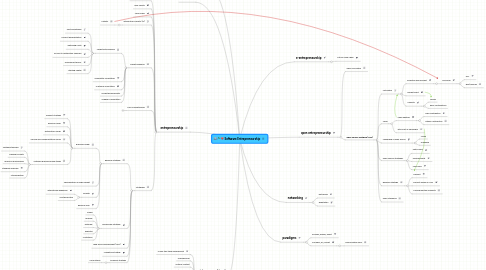
1. intrapreneurship
1.1. Under-the-table development
1.2. Championing
1.3. Cultural context
1.4. Cultural Barriers
1.5. Organizational Structure
1.6. Management
1.7. Training Intrepreneurs
1.7.1. Practical/Theortical
2. entrepreneurship
2.1. Venture Capital
2.2. goal variety
2.3. Value chain
2.4. Intellectual Property (IP)
2.4.1. Patents
2.5. Market Research
2.5.1. Market Entry Barriers
2.5.1.1. Cost advantages
2.5.1.2. Product differentiation
2.5.1.3. Switching costs
2.5.1.4. Access to distribution channels
2.5.1.5. Government policy
2.5.1.6. Starting capital
2.5.2. Competitor Orientation
2.5.3. Customer Orientation
2.5.4. Market Requirements
2.5.5. Supplier Competition
2.6. Core Competencies
2.6.1. Technological resources
2.6.2. Technological capabilities
2.6.3. Interaction Quality
2.7. Strategies
2.7.1. Business Strategy
2.7.1.1. Business Model
2.7.1.1.1. Product Strategy
2.7.1.1.2. Revenue Logic
2.7.1.1.3. Distribution Model
2.7.1.1.4. Service and Implementation Model
2.7.1.1.5. Software Business model types
2.7.1.2. Specialization in niche market
2.7.1.3. Growth
2.7.1.3.1. International expansion
2.7.1.3.2. Cost Reduction
2.7.1.4. Business Plan
2.7.2. Technology Strategy
2.7.2.1. leader
2.7.2.2. follower
2.7.2.3. extender
2.7.2.4. exploiter
2.7.2.5. Limitations
2.7.3. Lead Drivin Development (LDD)
2.7.4. Marketing Strategy
2.7.5. Financial Strategy
2.7.5.1. Consultancy
3. Vision
4. Social Network
5. e-entrepreneurship
5.1. Virtual Value Chain
6. open entrepreneurship
6.1. Open Innovation
6.2. Open Source Software (OSS)
6.2.1. Motivation
6.2.1.1. Effective and efficient
6.2.1.1.1. Licensing
6.2.1.2. Shows talent
6.2.1.3. Visibility
6.2.1.3.1. Trends
6.2.1.3.2. Early contributions
6.2.2. Value
6.2.2.1. Value addition
6.2.2.1.1. Own contribution
6.2.2.1.2. Others contribution
6.2.2.2. Total cost of ownership
6.2.3. Leadership in open source
6.2.3.1. Vision
6.2.3.2. Guidance
6.2.4. Open source strategies
6.2.4.1. Partly open
6.2.4.2. Opening parts
6.2.4.3. Fully open
6.2.5. Business strategy
6.2.5.1. Support
6.2.5.2. Product based on OSS
6.2.5.3. Complementary products
6.2.6. Open standards
7. paradigms
7.1. Analyze, Design, Enact
7.2. Consider, Do, Adjust
7.2.1. Improvisation skillls
